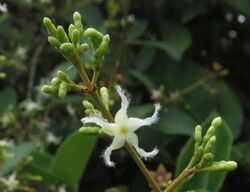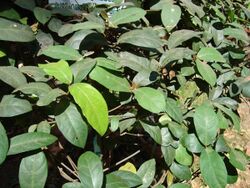Biology:Ichnocarpus frutescens
| Ichnocarpus frutescens | |
|---|---|

| |
| Scientific classification | |
| Kingdom: | Plantae |
| Clade: | Tracheophytes |
| Clade: | Angiosperms |
| Clade: | Eudicots |
| Clade: | Asterids |
| Order: | Gentianales |
| Family: | Apocynaceae |
| Genus: | Ichnocarpus |
| Species: | I. frutescens
|
| Binomial name | |
| Ichnocarpus frutescens | |
| Synonyms[1] | |
| |
Ichnocarpus frutescens is a species of flowering plant in the dogbane family Apocynaceae, known by the English common name black creeper.[2] It is native to much of China, India, Southeast Asia, and northern Australia.[1][3]
It is a woody shrub with lianas sprawling to 10 m (33 ft) in maximum length and 6 cm (2.4 in) in diameter. The bark produces a creamy white sap. The leaves are up to 11 cm (4.3 in) long by 4.5 cm (1.8 in) wide. The inflorescence is a head of several flowers. Each flower has a calyx of densely hairy sepals and a five lobed corolla just under a centimeter long. The fruit is a follicle which may be over 14 cm (5.5 in) long. The roots may be reddish or purple. The plant is sold in markets in some areas in India.[4]
Uses
The plant has a large number of traditional medicinal uses, including for rheumatism, asthma, cholera, and fever.[5] Some in vitro and rodent studies have suggested that extracts of the plant may inhibit tumors,[6] protect liver cells from damage in acetaminophen overdose,[7] and reduces complications of hyperlipidemia in diabetic rats.[8] There have been no published studies testing any of these effects in humans.
The fibrous bark is used to make rope.[3]
References
- ↑ 1.0 1.1 1.2 "Ichnocarpus frutescens". Royal Botanic Gardens, Kew. http://powo.science.kew.org/taxon/urn:lsid:ipni.org:names:79384-1. Retrieved 26 July 2020.
- ↑ "Ichnocarpus frutescens". Dave's Garden. https://davesgarden.com/guides/pf/go/242548/#b.
- ↑ 3.0 3.1 Li, Bingtao; Leeuwenberg, Antony J. M.; Middleton, David J. (2008). "Ichnocarpus frutescens, Apocynaceae, Vol. 16". in Wu, Z. Y.; Raven, P. H.. Flora of China. St. Louis, MO & Cambridge, MA.: Missouri Botanical Garden Press and Harvard University Herbaria. http://www.efloras.org/florataxon.aspx?flora_id=2&taxon_id=200018399.
- ↑ Barik, R., et al. (2008). Antidiabetic activity of aqueous root extract of Ichnocarpus frutescens in streptozotocin-nicotinamide induced type II diabetes in rats. Indian Journal of Pharmacology 40:1 19.
- ↑ Adhikari, B. S., et al. (2010). Medicinal Plants Diversity and their Conservation Status in Wildlife Institute of India (WII) Campus, Dehradun. Ethnobotanical Leaflets 14 46-83.
- ↑ Kumarappan CT, Mandal SC (June 2007). "Antitumor activity of polyphenolic extract of Ichnocarpus frutescens". Exp. Oncol. 29 (2): 94–101. PMID 17704739. http://www.exp-oncology.com.ua/en/archives/31/609.html. Retrieved 2011-09-26.
- ↑ Dash, D. K., et al. (2007). Evaluation of hepatoprotective and antioxidant activity of Ichnocarpus frutescens (Linn.) R.Br. on paracetamol-induced hepatotoxicity in rats. Tropical Journal of Pharmaceutical Research 6:3 755-65.
- ↑ Kumarappan CT, Mandal SC (2008). "Polyphenolic extract of Ichnocarpus frutescens attenuates diabetic complications in streptozotocin-treated diabetic rats". Ren Fail 30 (3): 307–22. doi:10.1080/08860220701857449. PMID 18350451.
Wikidata ☰ Q5986359 entry
 |


